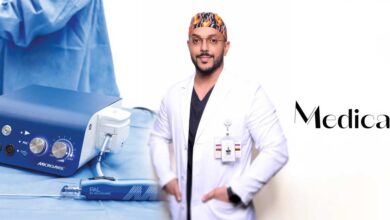Mona Mirza
Founder & CEO at Biolite Aesthetic Clinic, AURA 3D Imaging System – Biolite Clinic
Revolutionizing Skin Analysis for Precision and Personalized Care
The AURA 3D Imaging System represents a significant leap forward in skin analysis. It distinguishes itself from traditional 2D methods by capturing a true 3D digital replica of the face, chin, neck, and submental area. This advanced system utilizes multiple camera angles and synchronized flashes, ensuring consistent and clinically accurate scans regardless of external lighting or room conditions. This reliability is crucial for precise before-and-after comparisons and tracking changes over time.
Mona Mirza, Founder & CEO at Biolite Aesthetic Clinic, during an interview with ‘Hospitals’ magazine, explains that AURA 3D imaging system empowers practitioners to design highly tailored and results-driven treatment plans.
What sets the AURA 3D Imaging System apart from traditional skin analysis methods?
At Biolite Clinic, we’ve always invested in technology that enhances precision, improves consumer trust, and delivers measurable results, and AURA does precisely that. Unlike older 2D systems, AURA captures a true 3D digital twin of the face, chin, neck, and submental area, using multiple camera angles and synchronized flashes that are unaffected by external lighting.
It’s incredibly reliable. Each scan is consistent, regardless of the time of day or room conditions, which means that before-and-after comparisons are always clinically accurate.
The intuitive interface makes it effortless for our team to use during consultations, while the quantifiable data helps us map changes over time. It provides our practitioners with clarity and our consumers with confidence, which is precisely what modern aesthetic care should deliver.
How does the AURA 3D Imaging System enhance consumer care and treatment outcomes?
One of the most valuable things AURA brings to the table is clinical objectivity. It enables our doctors and therapists to see beyond what’s visible to the naked eye, offering measurable data on volume loss, asymmetry, textural issues, pigmentation, and more.
This enables us to design tailored, results-driven treatment plans and adjust them dynamically based on how the skin responds. Whether we’re tracking collagen stimulation after Sofwave or the volumetric balance following injectables, AURA gives us a clear roadmap. For consumers, it eliminates the guesswork from their journey, replacing it with trust, clarity, and a sense of control.
Can you describe the consumer experience during a typical AURA 3D Imaging System session?
It’s swift, clean, and non-invasive. The client aligns their eyes with a small on-screen guide, no chin rest, no harsh light, no discomfort. A series of brief, synchronized flashes captures multiple angles in one seamless scan.
From there, we walk the consumer through their 3D facial twin, highlighting key concerns and showing them precisely what we see, across zones like the forehead, cheeks, jawline, and neck. The entire experience feels elevated, professional, and deeply personalized, and often, consumers tell us they finally understand their skin on a whole new level.
In your opinion, how does the AURA 3D Imaging System contribute to the advancement of aesthetic medicine in the region?
AURA raises the standard for what aesthetic consultations should be, data-driven, transparent, and beautifully presented. In a region like ours, where clients are discerning and results-focused, this kind of clinical integrity is essential.
It empowers practitioners to move from opinion to evidence, and helps consumers feel genuinely informed, not just convinced. At Biolite, it has completely redefined the way we assess, plan, and communicate outcomes. It bridges the gap between artistry and science in a way that truly elevates the aesthetic conversation.
What types of skin concerns can the AURA 3D Skin Analyzer detect and monitor?
AURA is incredibly comprehensive. It can accurately identify and track:
- Wrinkles and fine lines.
- Volume loss and asymmetry.
- Pigmentation and UV damage.
- Texture irregularities and enlarged pores.
- Redness and vascular activity.
- Dynamic facial movement (neutral, smile, surprise, kiss).
- Skin tone evenness.
- Oil, hydration, and overall skin health scoring.
The 3D data and AI scoring help us understand not just what’s visible now, but what’s forming beneath the surface, giving us a head start in preventative care.
How do you see the future of skin analysis evolving with technologies like AURA?
The future is moving toward intelligent, predictive, and hyper-personalized skincare, and AURA is already paving that path. As AI continues to evolve, we expect to see systems that can forecast aging trajectories, recommend personalized protocols, and integrate seamlessly with electronic medical records (EMRs) and wearable diagnostics.
At Biolite, where aesthetics meets regenerative wellness, this level of insight will be invaluable, allowing us to treat not just what we see, but what we anticipate. Technologies like AURA are transforming consultations from reactive conversations into proactive, empowered journeys, which is precisely where modern medicine is heading.















